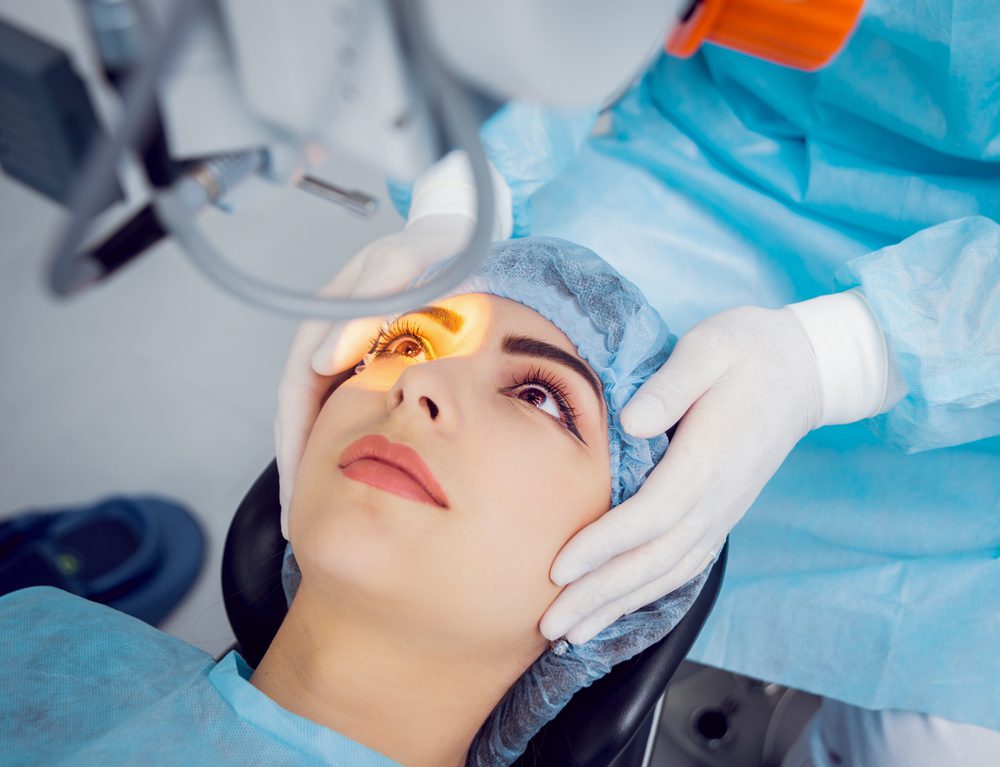What is the YAG Laser?
 The YAG laser is done in some cases after cataract surgery.
The YAG laser is done in some cases after cataract surgery.
The natural lens of the eye is situated in an elastic-like capsular bag that holds it in place. When performing cataract surgery, the surgeon carefully opens the front portion of the capsule in order to remove the lens. After completely removing the natural lens, the intraocular lens is positioned inside the capsular bag. The capsule holds the intraocular lens and serves as a protective barrier for the back of the eye.
After cataract surgery, the capsule may become cloudy and cause blurred, hazy vision. Some patients may experience glare or halos around bright lights. This condition occurs in as many as 40% of patients who undergo cataract surgery and may occur months or even years after cataract surgery.
If a patient begins to experience glare or halos as a result of the cloudy capsule a YAG laser may be done without the need for an anesthetic injection. There is no interruption in physical activity and no patch is required after the laser treatment. Dr. Thomas Crowley and his staff will make you feel comfortable at our Ocala office during treatment.
How do I know if I Need YAG laser treatment?
While most people who don’t already have 20/20 vision may think that their vision conditions are just a normal thing, sometimes these symptoms can be a sign that you may need YAQ laser treatment, especially if you have recently had cataract surgery done. Signs you may need YAG treatment include the following:
- Blurry vision
- Double vision
- Cloudy vision
- Vision blurred at night
- Glare
- Trouble seeing far
- Unclear vision while driving
- Dark spots
Who is the ideal candidate for laser treatment?
The ideal candidates for YAG laser treatments are those in overall good health who have had successful cataract surgery and are now experiencing trouble with clear vision. YAG laser capsulotomies will help improve your vision if it has recently been altered following your cataract surgery procedure. This treatment is most commonly performed on adults who are over 50 years old and is typically needed by more women than men. If you suffer from an autoimmune disease, diabetes, or have a health condition that makes it difficult for the body to heal from wounds and surgeries, this procedure may not be right for you.
Potential risks of the YAG Lasers
YAG laser capsulotomy is a very safe procedure. It is very rare for complications to occur. In most situations, patients notice temporary floaters in their field of vision. Floaters are small clusters of cells or matter inside the vitreous. These clumps create shadows on the retina. They may appear as dark specks or weblike strings floating across vision. Floaters are not dangerous and should clear up within a few days. Additionally, there is a potential for flashes to develop after the laser procedure. Flashes are a sign that the vitreous is pulling or rubbing on the retina. This should also resolve in a matter of days.
With laser capsulotomy, there are a few very low risks that patients should know. First, there is a chance that the intraocular lens inserted at the time of cataract removal could be displaced or damaged. There is a <1% of developing a retinal detachment. Were this to occur, surgery would be necessary. There is also a very small risk (<2%) of macular edema, a condition in which fluid builds up in the central part of the retina. Macular edema can reduce vision and may require treatment with eye drops, medication, or surgery.
When undergoing YAG laser capsulotomy, it is imperative that you remain still and do not move your eyes during the procedure. If you feel the need to move, inform the doctor before doing so.
Is it painful?
No. Your doctor may apply anesthetic drops before inserting a special contact lens into your eye. This lens focuses the laser beam exactly where it needs to create an opening in the capsule. The use of a laser does not hurt, even without numbing eye drops. What may feel slightly odd or uncomfortable is the contact lens or the instrument that holds the eyelids open. If you’ve had cataract removal, which is likely, then you are familiar with this instrument and may find it easily tolerable. Some patients do experience minor eye soreness for a few days following their procedure. Our team can discuss how to manage this side effect if it does occur.
How to prepare for treatment
There are no special precautions needed before the YAG laser capsulotomy can be safely performed. Dress comfortably for your appointment so you can easily move onto and off of the treatment table. Also, before your appointment, arrange to have someone drive you to the office. You will not be able to drive yourself home due to blurry vision created by the dilating eye drops.
How Is YAG Capsulotomy Performed?
Dilating drops are instilled and the laser is used to create an opening in the center of the cloudy capsule. Most patients notice an instant improvement in their vision, while others experience a gradual improvement over several days. YAG capsulotomy is an outpatient procedure and takes just minutes to perform.
What is recovery like?
Because the YAG laser capsulotomy requires dilation of your eyes, you may want to take the rest of the day off from work and other activities. Due to dilation, it is best to arrange to have someone drive you home from your appointment. Until your pupils have returned to normal, your vision may be blurry and your eyes may be sensitive to light. With this in mind, you may want to return home and rest with your eyes closed for a few hours. As you feel well enough, you may return to normal activities. There are no restrictions aside from your own comfort level. You may be sent home with eye drops or a prescription for eye drops to use for a few days to a few weeks. These are meant to reduce inflammation that may occur as a result of the laser treatment.
What happens if my vision is still blurry after my YAG laser treatment?
The YAG laser procedure is meant to be quick and precise and most patients can return back to their normal routines with improved vision the next day. However, if you find that you are still having vision complications 48 hours after your treatment, it is recommended to contact Dr. Croley and our team again so we can monitor your progress. Despite the possibility of this complication, Dr. Croley takes great care in prioritizing the health, safety, and satisfaction of patients for each treatment, and blurred vision post-YAG laser treatment is rare and usually avoided.
How to maintain your results

Can I combine the YAG Laser with other procedures?
The YAG laser capsulotomy is usually performed independently of other procedures. The doctor may make this determination on a case-by-case basis depending on various factors relating to the patient’s eye health and general health.
Schedule a Consultation in Ocala, FL
To learn if you are a candidate for YAG Laser Treatment, schedule a consultation at Central Florida Eye by calling our office at (352) 237-8400.
